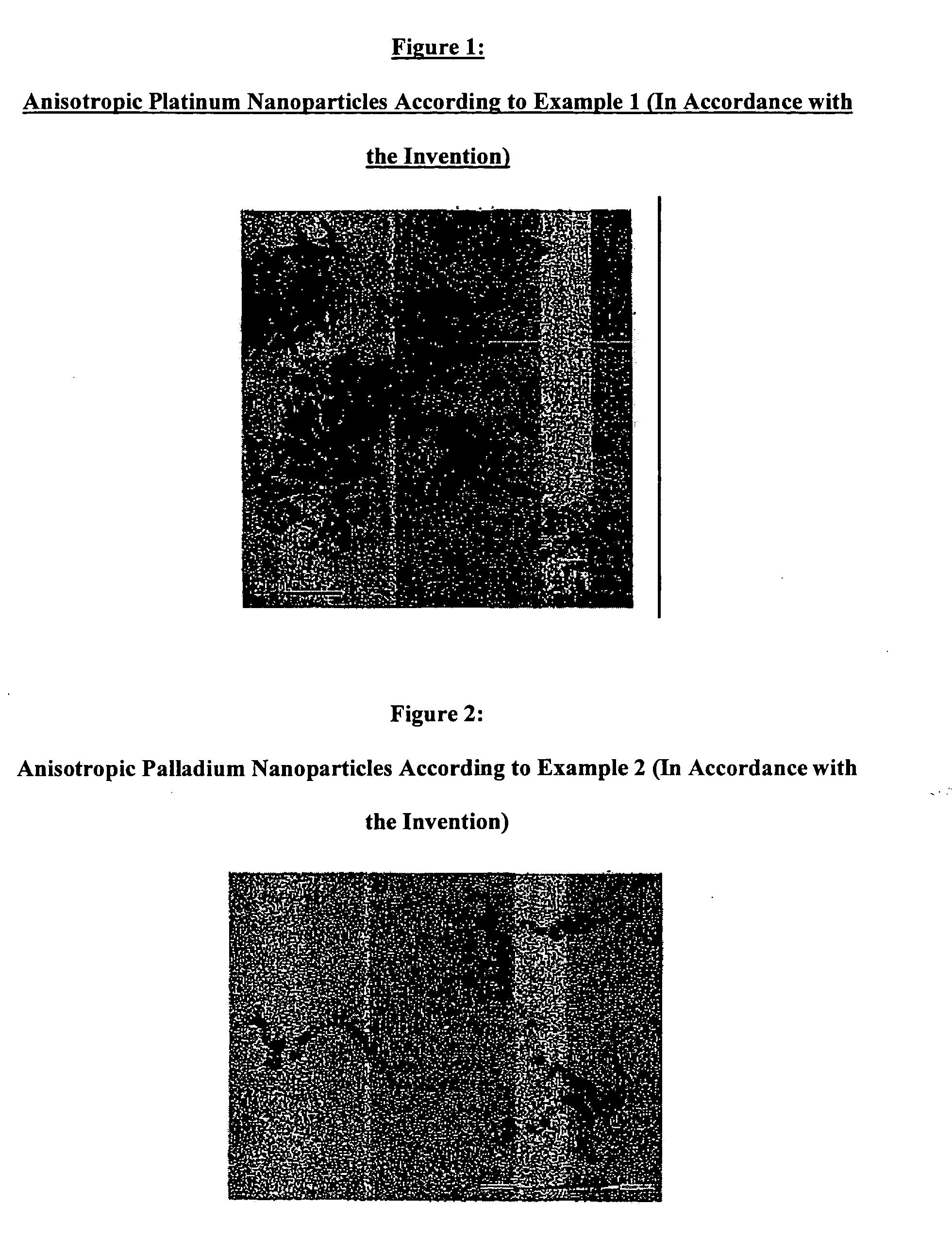Method for synthesizing a catalyst based on anisotropic metallic nanoparticles by a micellar means
a technology of anisotropic metallic nanoparticles and micellar means, which is applied in the direction of catalyst activation/preparation, metal/metal-oxide/metal-hydroxide catalysts, etc., can solve the problems of insufficient yield of anisotropic nanoparticles and drawbacks of using slightly reducing organic compounds, and achieve good morphological monitoring
- Summary
- Abstract
- Description
- Claims
- Application Information
AI Technical Summary
Benefits of technology
Problems solved by technology
Method used
Image
Examples
example 1
Synthesis of Anisotropic Platinum Nanoparticles on an Alumina Substrate
Catalyst A, in Accordance with the Invention
[0130] A solution of metallic precursor was prepared by dissolution of 0.72 g of [Pt(NH3)4]Cl2 in 100 ml of water thermostated to 35° C. The cetyl trimethylammonium bromide (CTAB) (43.7 g) was added to the metallic precursor solution to obtain a concentration of 1.2 mol / L. The reducing agent (NaBH4, 76 mg in 5 ml of H2O) was added while being stirred vigorously. The solution was stirred by remaining at 35° C. for 30 minutes, a period at the end of which the solution turns black. After reduction, the solution was diluted in water. Platinum nanothreads were thus obtained.
[0131] A photograph by electron microscopy of these nanoparticles is provided in FIG. 1. The mean dimensions of these nanothreads are about 20 nm in length and 3 nm in width. The mean shape factor of the nanoparticles is equal to 0.4. These nanothreads were washed several times with hot water and separ...
example 2
Synthesis of Anisotropic Palladium Nanoparticles on an Alumina Substrate
Catalyst B, in Accordance with the Invention
[0133] A metallic precursor solution was prepared by the dissolution of 0.49 g of [Pd(NH3)4]Cl2 in 100 ml of water thermostated to 35° C. The cetyl trimethylammonium bromide (43.7 g) was added to the solution to obtain a concentration of 1.2 mol / L. The reducing agent (NaBH4, 76 mg in 5 ml of H2O) was added while being stirred vigorously. The solution was stirred for 5 minutes, a period at the end of which it turns black. After reduction, the solution was diluted in water.
[0134] A photograph by electron microscopy of these nanoparticles is provided in FIG. 2. The palladium nanothreads were then washed with warm water and separated by centrifuging. The nanothreads have a particular “pearl necklace” shape with dimensions of 80-100 nm in length and 10 nm in thickness. The mean shape factor of the nanoparticles is equal to 0.25.
[0135] After redispersion in water, the Pd...
example 3
Synthesis of Anisotropic Cobalt Nanoparticles on an Alumina Substrate
Catalyst C, in Accordance with the Invention
[0136] A metallic precursor solution was prepared by dissolution of 0.72 g of Co(NO3)2 in 100 ml of water thermostated to 35° C. The cetyl trimethylammonium bromide (CTAB) (43.7 g) was added to the metallic precursor solution to obtain a concentration of 1.2 mol / l. The reducing agent (NaBH4, 76 mg in 5 ml of H2O) was added while being stirred vigorously. The solution was stirred for 30 minutes, a period at the end of which the solution turns black. After reduction, the solution was diluted in water.
[0137] Co nanothreads were thus obtained. Their mean dimensions are about 25 nm in length and 2 nm in width. The mean shape factor of the nanoparticles is equal to 0.2. These nanothreads were then washed several times with warm water and separated by centrifuging.
[0138] After redispersion in water, the cobalt nanoparticles were deposited on alumina (Al2O3) by dry impregnati...
PUM
| Property | Measurement | Unit |
|---|---|---|
| temperature | aaaaa | aaaaa |
| temperature | aaaaa | aaaaa |
| mean size | aaaaa | aaaaa |
Abstract
Description
Claims
Application Information
 Login to View More
Login to View More - R&D
- Intellectual Property
- Life Sciences
- Materials
- Tech Scout
- Unparalleled Data Quality
- Higher Quality Content
- 60% Fewer Hallucinations
Browse by: Latest US Patents, China's latest patents, Technical Efficacy Thesaurus, Application Domain, Technology Topic, Popular Technical Reports.
© 2025 PatSnap. All rights reserved.Legal|Privacy policy|Modern Slavery Act Transparency Statement|Sitemap|About US| Contact US: help@patsnap.com

